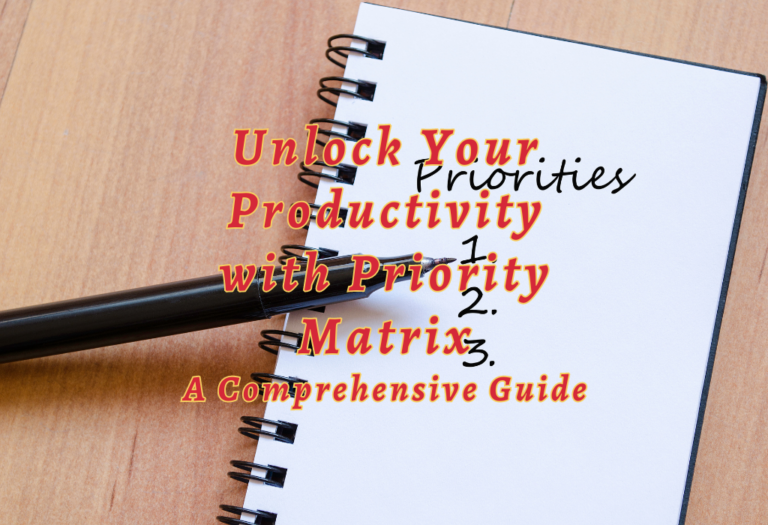Unlock Your Productivity Potential: What is Productivity?
Do you know what productivity means? You may be surprised to learn that it’s not just about how quickly you can get a task done – and that it has a much more meaningful impact on your success than simply ticking off a to-do list.
In this blog post, we’ll take a look at what productivity means and how you can use it to reach your full potential and push the boundaries of your day-to-day performance.
From why productivity matters to the simple steps you can take to increase it, this post will help you unlock your ability to get the most out of your productivity, now and in the future.
We’ll explore both the tangible and subconscious actions you can take to maximize your productivity and show you how to be productive without feeling overwhelmed.
Are you ready to unlock your true productivity potential and move mountains? Let’s get started.

Quick Insight into Key Points
Productivity is a measure of how efficiently resources are being used to produce goods and services. It is calculated by dividing output by input, as resources like labor and materials are used to produce outputs like products and services.
Understanding Productivity
Productivity is the measure of how efficiently a person, team, or organization can create valuable products or services. It is essential for improving economic growth and the rate of success. By understanding what productivity is and the factors that influence it, individuals can increase their overall productivity.
Types of productivity
Productivity can be broken down into two types: relative productivity and absolute productivity.
The main factors that influence personal productivity are
These four aspects are interrelated and can have both positive and negative impacts on individual productivity. To maximize personal productivity, it is important to pay attention to each factor and actively work to improve them all.
Studies and reports on productivity strategies
Increasing Personal Productivity
Increasing personal productivity requires that we first understand it and then identify and address the areas slowing down our progress.
However, understanding and recognizing personal productivity as a measure of progress towards desired outcomes, allow for self-evaluation and opportunity for self-improvement. To increase one’s productivity, begin by taking an inventory of individual skills, strengths, and weaknesses. Commonly used methods include time-management tracking tools and the use of calendars to track task completion; these allow for insight into specific areas for prioritization and improvement. Additionally, to maximize productivity, it is important to create achievable plans with clearly outlined objectives and timelines to both prioritize activity as well as gain a sense of accomplishment once described tasks are completed. Adopting accounts focused on eliminating unnecessary actions helps in simplifying decision-making processes.
Establishing healthy routine
practices such as exercising regularly, eating well, and staying hydrated can benefit energy levels contributing to improved focus. Perfectionism can prove detrimental when seeking productivity gains; oftentimes perfectionism postpones the completion of tasks due to an excessive focus on details versus the result achievement objective; it is both important to recognize that perfectionism will lead to procrastination or even burn out impacting overall output.
Taking short breaks
On the other hand, consistency—over perfectionism—is key; consistent effort across an extended timeframe yields greater results than sporadic bursts of effort within short intervals followed by periods of idleness.
Boosting productivity by Prioritizing and Organizing Tasks
To unlock your productivity potential, it is important to prioritize and organize tasks correctly.
Establishing a to-do list
is a great starting point. Prioritize the list from most important tasks to least important, and break them down into small achievable steps whenever possible. Before commencing with a task, take some time to think if it is really necessary at that moment, or if it would be better to put it off until later on in the day or week. Make sure to give yourself a timeline for each task and ensure that sufficient time has been allocated for each item; this will help you keep track of progress and avoid feeling overwhelmed.
Adapting strategy and relaxing
Having organized a list of tasks, another strategy worth adopting is structuring your day effectively by breaking your day into manageable chunks of time which should ideally involve both hard work and relaxation periods throughout; this way fatigue can be avoided which can significantly affect your performance as well as your physical health.
Incorporating leisure activities such as walking/running or practicing yoga/meditation can not only help clear your mind and replenish energy levels but also have multiple positive physiological effects such as improved sleep quality and better brain function.
Now that we have explored how prioritizing and organizing tasks can help unlock productivity potential, let us turn our attention to maximizing efficiency through the effective utilization of tools in the next section.
Utilizing Effective Tools
Utilizing effective tools is another key aspect of unlocking an individual’s productivity potential. Technology has made it easier than ever to improve personal efficiency and manage time better. Mobile devices, software solutions, and task management tools are just a few of the readily available resources that can be used to foster higher productivity levels.
Productivity hacks
Productivity hacks such as:
These can also be extremely helpful in helping individuals reach their potential. As much of this technology can be customized based on individual preferences, users will be able to tailor the options they use most often and create an efficient framework that works for them.
Overuse of tech should be avoided; instead, strive for a balance between relying on tools to achieve long-term goals and maintaining a presence to maximize return rate on short-term objectives.
Productivity in the Workplace
Productivity in the workplace is a key element in the success of any organization.
Increasing productivity has a direct impact on profitability, so employers need to invest in management practices, technological advancements, and employee training that improve how work is done.
use of automated software and technology
By using technology and automated software, it is possible to reduce the use of manual labor to accomplish tasks extremely quickly. This can result in improved outcomes in terms of getting more products or tasks done by a smaller number of employees. Additionally, proper use of technological tools can increase collaboration and communication across teams, potentially improving productivity and morale.
Drawbacks
On the other hand, not all productivity techniques are beneficial for employees. Automated software and algorithms can force employees to work faster than they are able as well as remove the satisfaction that comes with completing tasks without any assistance. This leads to a phenomenon known as “tech fatigue” where employees become exhausted due to over-use of technology and lack of autonomy. This can lead to decreased motivation, morale, job satisfaction, and ultimately lower productivity levels in the workplace.
Developing Efficient Processes
Developing efficient processes for achieving optimal productivity is a key component of unleashing an organization’s full potential. Without streamlined, well-designed processes, operations can become bogged down in inefficiency and complexity, wasting time and energy. When executed correctly, process improvement has the power to dramatically optimize production flow, improve output quality and open up space for further innovation.
Prioritize and organize
One approach to improving workplace processes is focusing on removing wasteful steps or tasks from existing workflows. The elimination of activities that do not directly contribute to advancing the core goal of tasks can help free up resources for activities more likely to provide value. This could include streamlining the approval process within a department by introducing cross-functional teams or quickly integrating feedback loops with stakeholders so changes can be made in real time instead of after the fact.
Keeping track of progress
In addition to streamlining operations, it is also important for organizations to pay special attention to data collection and management procedures as part of their efficiency improvement efforts. By tracking performance metrics regularly, teams can accurately measure progress against goals, gain insights into areas where improvements are needed, prioritize resources better and react quickly in a highly competitive market.
By developing efficient processes designed to leverage employee strengths and address weaknesses, organizations can unlock their full potential and maximize their productivity
Main Points to Remember
Productivity can have significant positive impacts on life and work. Achieving optimal productivity can help to increase effectiveness, time management, organization, process improvement, and task orientation. This can save time, which in turn leads to faster completion of projects with greater results. As such, there are several good reasons why people strive for higher productivity:
With this in mind, it is clear that there are numerous benefits associated with aiming for maximum productivity. But how then do we achieve it? Taking a productive approach will be discussed further in the following section…
Taking a Productive Approach
Having a productive approach to work is essential for maximizing output and achieving goals. Taking a productive approach to tasks means breaking down a task into smaller steps, developing successful strategies for completing each step, and holding yourself accountable to execute them most efficiently.
Task Management
Successful task management is an important part of taking a productive approach to work. Creating a timeframe for each task and then scheduling each one accordingly, allows an individual to clear their mental space so they can stay focused on the task at hand instead of ruminating about upcoming tasks. Additionally, fixed reminders of upcoming deadlines help make sure that all tasks are completed on time.
Time Management
Another necessary component of taking a productive approach is good time management. To maximize output, it’s important to understand what tasks require your full attention and allocate time accordingly. Achieving this requires creating personal processes and routines as well as staying mindful of distractions throughout the day. By using this strategy, individuals can retain focus during intense working periods while simultaneously allowing sufficient recovery time afterward.
Delegating Tasks
Identifying when it’s appropriate to delegate tasks is another skill crucial to taking a productive approach. Not only does delegating jobs to ensure completion within set parameters but it also increases personal productivity by freeing up more time for more important jobs. Doing so also enables higher quality outputs due to diversity in skillset approaches as other people’s views often assist with seeing clearer paths forward while providing novel solutions to roadblocks encountered when working independently. However, successful delegation relies upon clear communication to effectively distribute information amongst members of the team which can sometimes incur additional time costs in the short term before benefits can be reaped from incorporating different perspectives over the long run.







